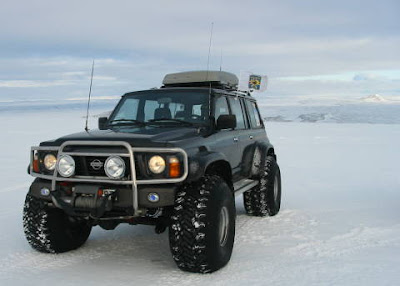


Mitsubishi Pajero 3.5 GLS 4x4
A strong heritage can be both a blessing and a curse. In choosing from the huge clutter of turf-tackling wagons on the market these days, an SUV with the Mitsubishi Pajero's illustrious history comes with ready-made credibility, but it can also create unreasonably high expectations.
The Pajero's successful off-road exploits, including several Dakar victories, have successfully wooed adventure-spirited motorists all over the world since its launch in the early 1980s.
The style and all-terrain versatility that made its predecessor a best-seller is recreated in the latest Pajero - launched here in May in a six-model range of short- and long-wheelbase derivatives - but not without some flaws.
A stint behind the wheel of the GLS 3.5 litre long-wheelbase version revealed notable improvements over the old Pajero but with some drawbacks that peg the newcomer a half-notch lower than the top SUVs.
DESIGNA big SUV such as a Pajero can be the best cure for the urban blues. Clambering through the undergrowth in a 4x4 can sterilise the stress of a manic week spent with kamikaze minibuses and fast-lane dawdlers, which is probably why the SUV market has grown so rapidly over the past few years.
Mitsubishi's latest bundu brawler is a broad, comfortable rig with eye-catching styling and big muscle that ferries up to seven passengers over all sorts of territory.
A monocoque body is the most significant change to the newcomer, replacing the previous truck-like ladder frame chassis with a unitary body that has increased torsional strength, improved cabin room and lowered the centre of gravity.
All very nice, but let's get down to basics: the Pajero's flashy posing power alone will be more than enough to elicit a down-payment from many SUV aspirers.
With its art-deco lights and belligerent body armour, the Pajero looks like a cast-off from the WesBank Modified challenge and if standing out is your thing, the Mitsubishi's the Naomi Campbell of the urban jungle catwalk.
INTERIORThis eye-catching design flair continues into the stylish cockpit, a tasteful flamboyance with lots of nice touchy-feely bits such as the dimpled finish on the steering wheel, door handles, gearlevers and handbrake.
Broad, comfortable leather-clad seats take care of the passengers, and take the punishment out of driving over harsh surfaces.
Cabin room has grown over the previous generation and is simply enormous. Excellent passenger/cargo versatility comes from a back seat that can be stored in the underfloor compartment to provide unhindered luggage space, or removed if the underfloor area is also required, while the middle seats fold forward.
Gone are the altimeter and incline gauges that perched atop the old Pajero's dash, but there's a trip computer with useful info to scroll through, such as outside temperature, audio information, average speed and fuel consumption.
Ergonomics are first-class, with the radio and ventilation controls high-mounted for easy reach, while the steering wheel is height-adjustable and the driver's seat has electric controls.
The array of gimmicks and comforts rivals any luxury limousine, and includes cruise control, a CD sound system, and automatic climate control with separate ventilation controls for the rear passengers.
PERFORMANCETwo engines are available: a 16-valve 3.2 diesel and a 3.5 petrol 24-valve V6. The petrol V6 and five-speed transmission of our test vehicle coped admirably with lugging such a big piece of SUV around. In fact, this Pajero is one of the brawniest 4x4s available and has healthy power on tap, whether cruising the fast lane or sprinting from the traffic lights.
The mighty Mitsubishi eats up the Reef's 0-100km/h sprint in just over 11 seconds, a superb feat for a two-ton Tessie and likely to cause some red faces among the pocket-rocket brigade. The only SUV that outguns it is the 4.7-litre V8 Jeep Grand Cherokee, at 9.7 sec.
Similarly impressive is the efficiency of the braking, with anti-lock assistance helping bring the heavy behemoth from 100km/h to rest in only 3.2 seconds.
HANDLINGAll-independent suspension replaces the previous independent front and solid rear axle setup while the wheelbase and track width have grown. All this has transpired in an effort to improve handling but the long-wheelbase Pajero is a soggy, unwieldy beast on the tar, with a vague steering action.
Unfortunately, the net result was a roll-over when we flicked the Mitsubishi into a tight corner at Gerotek's ride and handling circuit.
It simply cocked its wheels like a dog at a lamp post and tipped on to its right side when we simulated an emergency lane change - a worrying occurrence as a vehicle's not supposed to fall over simply by driving into a bend too fast, and usually needs to be tripped-up by something like a kerb or a ditch.
We believe the culprits were a too-high centre of gravity coupled with very grippy tyres.
OFFROADThe Pajero's off-road prowess helped raise its estimation somewhat but here, too, it ran into some obstacles.
The impressive bit is Pajero's trademark Super-Select all-wheel-drive system, one of the best in the business for its near-effortless convenience.
It allows you shift-on-the-move between two and all-wheel-drive at speeds up to 100km/h and back at any speed and has four modes: standard rear-wheel-drive, al-wheel-drive in high range, plus high and low-range modes with the centre differential locked.
There is pretty much enough traction to get you scrambling up the most slippery and bumpy hill, churn through squishy riverbeds and sail effortlessly over axle-twisters.
Unfortunately, little praise can be levelled at the long-wheelbase Pajero's departure angle when climbing a sharp slope and the bottom of the rear chassis was often snagged during our off-road test. Pity, as it means the Pajero will risk some damage if it tries to play follow-the-leader with the likes of a Range Rover, Patrol or Grand Cherokee in very rocky and mountainous terrain.






























